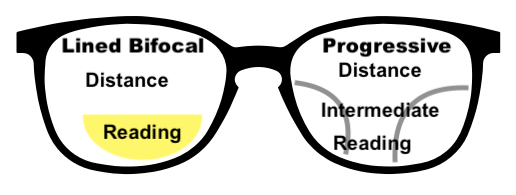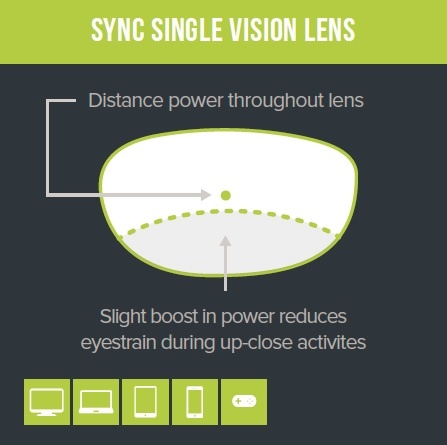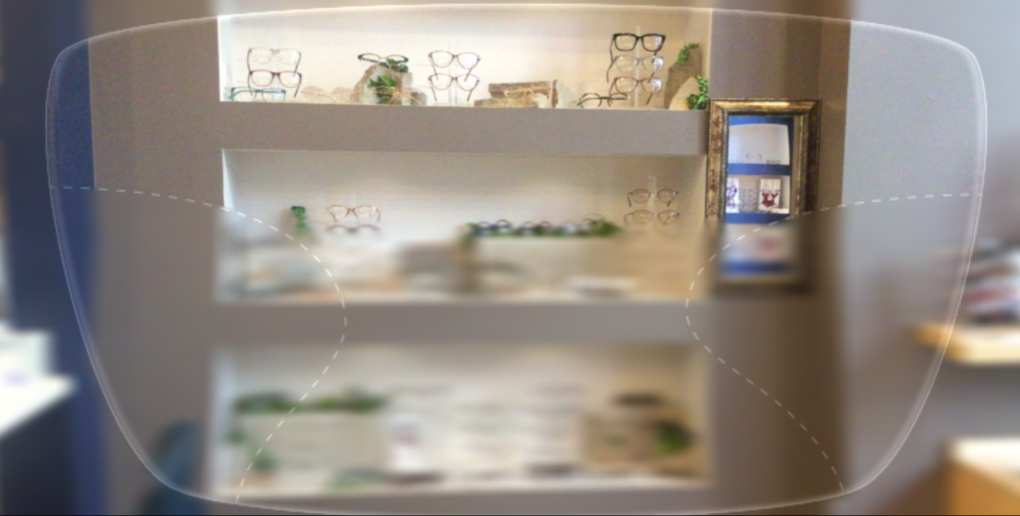By: Brent Jones
ABO Certified Optician
Whether you need a progressive lens, a digital single vision lens to reduce eye strain, or even a traditional lined bifocal lens, selecting the right one for your needs can be overwhelming. As an ABO Certified Optician, I have been selling multifocal lenses for many years but haven’t personally worn them until a year ago. During the past year I have tried several types of progressive lenses and enhanced digital single vision lenses and based on my personal experience I highly recommend getting them as soon as possible.
Typically around the age of 40, our eyes are not able to compensate for near viewing distances and we begin to need a progressive or bifocal lens. While this is a good rule of thumb, because of the digital device lifestyle we have adopted over the past 10 years, eye strain is more and more common at drastically younger ages. So, depending on the prescription you need and your lifestyle, a multifocal lens option may be a good solution for you at any age. So, what is the difference between enhanced digital single vision, lined bifocal, and progressive lenses?

An enhanced digital single vision lens in the simplest form is your distance prescription with a small “bump” of power at the bottom to help with near vision. These are ideal for minus prescriptions that spend a lot of time on digital devices such as laptops and smartphones or emerging presbyopes who have just started requiring help to read small print.
A lined bifocal lens is a traditional multifocal lens that has one prescription throughout the top of the lens and a small area with a second prescription at the bottom. The small area is typically a half circle shape with a flat top. This is why these are often referred to as “flat top” bifocals. They come in a variety of widths and can be placed at different heights to customize the lens for the user’s unique needs. Usually the top portion of the lens is used for the distance prescription and the bottom is for reading, but the prescription can be altered for computer work, distance and computer, or occupational lenses.
Finally, a progressive lens is a “no-line bifocal” as it has distance prescription at the top and reading at the bottom. Unlike a lined bifocal, progressive lenses also have an intermediate area in between the distance and reading zones. This lens is designed to imitate natural vision at any distance. While this lens imitates natural vision better than other options, it typically takes your brain a few days to one week to accommodate to. The edges of the lens and both areas to the side of the reading channel are significantly more distorted than with single vision or bifocal lenses. The size of the distorted areas on the sides of the lens vary depending on your prescription and the type of progressive lens you buy.
There are several companies who make progressive lenses including Hoya, Zeiss, Varilux, and Shamir. I tried two lenses from different companies and based on my experience, I highly recommend a premium progressive digitally surfaced lens. These lenses are digitally made with a laser to your exact prescription on both surfaces of the lens giving you the best vision at any distance throughout the entire lens. They are typically more expensive than standard progressive lenses but they are well worth the investment. The standard progressive lens I tried was not a good experience. My best description of the vision was the lens constantly felt dirty on the edges and was bothersome even after wearing them for more than a week. After trying these, I then purchased a set of Hoya Premium Progressive lenses and the difference was night and day. The amount of distortion at the edge of the lenses was hardly noticeable and my entire computer screen was in focus. While adapting to the magnification at the bottom of the lens still took a few days, overall the lens was comfortable from the minute I put them on.
The other lens type I have been very pleased with is an enhanced digital single vision lens. I have tried both the Essilor Eyezen and Hoya Sync III. Honestly I did not notice a huge difference in the vision between the two, but I feel the clarity of the Hoya lens is slightly better.

Both are very comfortable for my distance prescription with an equivalent of one diopter of add power at the bottom. There is very little distortion in the lens but the reduction in eye strain when working on the computer or reading up close is significant. Overall, I am very pleased with the Sync III and highly recommend it to anyone who spends a significant amount of time on digital devices or first time progressive wears like myself who require lower add powers.
Overall, my recommendation is to get started wearing a multifocal lens as soon as you need it. Don’t be afraid of the stories you hear about how terrible progressive lenses are. As long as you start wearing them early and invest in a great lens you should have no trouble adapting and your eyes will thank you. Talk to a great optician about your lens options, select a frame that works, and you will see a huge difference in the amount of eye strain you experience.

